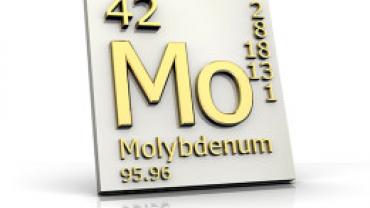
Let's face it. Molybdenum just isn't the most talked about mineral but that doesn't minimize its significance to human health. Molybdenum is an essential trace element found in small amounts in the body and the diet and has been found to be beneficial for detoxification particularly for individuals with Candida albicans.
Walter H. Schmitt Jr. D.C. and Richard Mowles M.D. followed Candida patients through a number of studies and discovered that molybdenum's importance in these patients is paramount. Candida is a yeast that feeds on sugar that when fermented creates toxins in the body such as acetylaldehyde. Molybdenum converts acetylaldehyde into acetic acid so that it can be excreted or used for energy. Mowles Schmitt et. al. ran a number of trials on patients with fragrance or airborne odor sensitivities and discovered “In 15 patient trials with weakening on smelling formaldehyde 14 were found to strengthen on molybdenum." Problems with the aldehyde oxidase enzyme system typically causes Candida patients to have issues with olfactory challenges to aldehyde and molybdenum most commonly strengthens weak muscles and negates the weakening response when individuals sniff aldehyde. According to the researchers “Candida albicans allergy [may be] due to the chronic long term stimulation of the immune system free radical release and antioxidant depletion. Imagine the chemical stress a patient's tissues must be under when constantly exposed to free radicals sulfites acetaldehyde and ammonia all of which have accumulated in the tissues due to an unmet molybdenum requirement of the patient."
Molybdenum is not only a necessary cofactor for the aldehyde oxidase enzyme system but also for xanthine oxidase and sulfite oxidase thus playing a role in detoxification and many other important biological processes.
In a study published in the Journal of Trace Elements in Medicine and Biology molybdenum has been shown to have hepatoprotective potential in rats with carbon tetrachloride (CCI4)-induced liver damage. Serum alanine aminotransferase aspartate aminotransferase and alkaline phosphatase levels were increased and antioxidant enzymes superoxide dismutase and catalase in the liver were reduced with CCI4. Molybdenum supplementation brought these changes to nearly undetectable levels.
In another recently published study the hepatoprotective effects of molybdenum were looked at and it was found to attenuate bile duct ligation (BDL) in animal models. In this study BDL increased serum levels of aspartate aminotransferase alanine aminotransferase alkaline phosphatase total bilirubin and direct bilirubin whereas it reduced the levels of antioxidant enzymes superoxide dismutase and catalase in the liver as well as induced liver fibrosis. Molybdenum supplementation delivered once a day via intragastric gavage (through a tube passed into the stomach) for 45 consecutive days negated all of these changes. It had an antifibrotic effect most likely due to its antioxidant properties.
In recent years molybdenum has also been identified as having other detoxification properties. Two subpathways of molybdenum cofactors have been found to employ activity capable of inactivating toxic compounds including E. coli. Molybdenum's possible connection to this detoxification may include the reduction of N-hydroxylated base analogs such as 6-N-hydroxylaminopurine (HAP) to its non-toxic amine adenine. In doing so molybdenum enzymes may be involved in protecting cellular DNA from these toxic compounds.